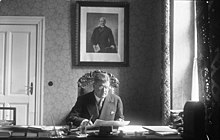Otto Meissner
Otto Meissner | |
|---|---|
Staatssekretär | |
| In office November 1923 – 1 December 1937 | |
| Staatsminister | |
| In office 1 December 1937 – 30 April 1945 | |
| Personal details | |
| Born | 13 March 1880 German Army |
| Unit | 136th Infantry Regiment |
| Battles/wars | World War I |
| Awards | Iron Cross |

Otto Lebrecht Eduard Daniel Meissner (13 March 1880 – 27 May 1953) was head of the Office of the President of Germany from 1920 to 1945 during nearly the entire period of the Weimar Republic under Friedrich Ebert and Paul von Hindenburg and, finally, under the Nazi government under Adolf Hitler.
Life
The son of a postal official, Meissner studied law in
Thanks to his good contacts, in 1919, Meissner became Acting Advisor in the "Bureau of the
Hindenburg presidency (1925-1934)
Meissner continued in the post of State Secretary when Paul von Hindenburg was elected as Ebert's successor in 1925. Meissner, who lived with his family in the palace of the German president between 1929 and 1939, undoubtedly enjoyed major influence upon the presidents, especially Hindenburg. Together with Kurt von Schleicher and a few others, Meissner, in 1929 and 1930, furthered the dissolution of the parliamentary system by means of a civil presidential cabinet.
His role in the appointment of Hitler to chancellor from December 1932 to January 1933 remains a controversy among historians. As a member of the "camarilla", Meissner was certainly no small influence as State Secretary because of his close relations with Hindenburg. Together with Oskar von Hindenburg and Franz von Papen, Meissner organized the negotiations with Hitler to depose von Schleicher and to appoint Hitler to the post of Chancellor. For the Nazis' part, the talks were facilitated through Wilhelm Keppler, Joachim von Ribbentrop and the banker Kurt Freiherr von Schröder, a former officer and head of the old-guard conservative "Herrenklub" (Gentlemen's club) in Berlin in which von Papen was also active. Neither Hitler nor Hindenburg, as of the end of 1932, would have initiated contact with each other, so great was their mutual distaste.[citation needed]
Meissner submitted his resignation in 1933 but it was refused.[citation needed]
Nazi period (1934-1945)
When Hitler merged the functions of head of state (the president) and head of government (the chancellor) in August 1934, Meissner's office was renamed the "Presidential Chancellery" and restricted in its responsibilities to representative and formal matters of protocol, while all more political matters were assigned to the Reich Chancellery under the direction of Hans Lammers. Meissner was also made a member of the Academy for German Law.[1] To mark the fourth anniversary of the Nazi regime on 30 January 1937, Hitler personally conferred the Golden Party Badge upon several non-Nazi members of the Reich government, including Meissner (membership number 3,805,235).[2] On 1 December 1937, Meissner was promoted to Minister of State (Staatsminister) and Chief of the, now again renamed, "Presidential Chancellery of the Führer and Chancellor". He was granted status equal in rank to a Reichsminister, but without the title.[3] Politically, his influence in the Hitler regime was distinctly minor.[citation needed]
Post-war
After the
In 1950, Meissner published a memoir covering his unusual bureaucrat's career in a book, State Secretary under Ebert, Hindenburg and Hitler. The writer Hans-Otto Meissner (1909–1992) was his son.
List of works
- Die Reichsverfassung. Das neue Reichstaatsrecht für den Praktischen Gebrauch, Berlin, 1919
- Das neue Staatsrecht des Reichs und seiner Länder, Berlin, 1921
- Grundriß der Verfassung und Verwaltung des Reichs und Preußens nebst Verzeichnis der Behörden und ihres Aufgabenkreises, Berlin, 1922
- Staatsrecht des Reichs und seiner Länder, Berlin, 1923
- Staats- und Verwaltungsrecht im Dritten Reich, Berlin, 1935
- Deutsches Elsaß, deutsches Lothringen. Ein Querschnitt aus Geschichte, Volkstum und Kultur, Berlin, 1941
- Elsaß und Lothringen, Deutsches Land, Verlagsanstalt Otto Stollberg, (324 pages), Berlin, 1941
- Staatssekretär unter Ebert, Hindenburg, Hitler. Der Schicksalsweg des deutschen Volkes von 1918 – 1945. Wie ich ihn erlebte, Hamburg, 1951
References
- ISBN 978-3-10-039326-5.
- ^ "Nazi Conspiracy and Aggression, Volume V, pp. 543-544, Document 2879-PS" (PDF). Office of United States Chief of Counsel For Prosecution of Axis Criminality. 1946. Retrieved 26 April 2021.
- ^ "Nazi Conspiracy and Aggression, Volume IV, p. 724, Document 2097-PS" (PDF). Office of United States Chief of Counsel For Prosecution of Axis Criminality. 1946. Retrieved 26 April 2021.
Sources
- ISBN 3-7610-7216-3
- ISBN 978-3-596-16048-8
- ISBN 3-406-44037-1
- ISBN 0-02-630600-X
External links
 Media related to Otto Meissner at Wikimedia Commons
Media related to Otto Meissner at Wikimedia Commons- Works by or about Otto Meissner at Internet Archive
- Newspaper clippings about Otto Meissner in the 20th Century Press Archives of the ZBW
